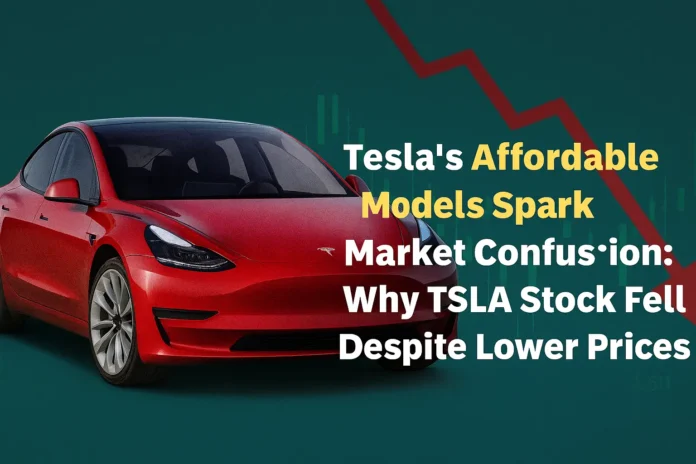Tesla’s latest move to make its cars more affordable didn’t quite get the market cheering it was hoping for.
On the day Tesla unveiled the new Model 3 Standard at $36,990 and Model Y Standard at $39,990, TSLA stock slid 4.5%, according to Google Finance.
On paper, it looked like a win for everyday buyers — cheaper Teslas for the masses. But Wall Street’s reaction hinted at a more complex story. Investors aren’t just looking at the sticker price; they’re thinking about incentives, features, and long-term demand.
Let’s break down why Tesla stock dropped, what’s happening with deliveries, and what investors should be watching as we head into the next earnings report.
Why Did Tesla Stock Fall After Launching Cheaper Models?
At first glance, lower prices should boost demand. But Tesla’s new “affordable” models come with a big catch.
The $7,500 federal EV tax credit, which fueled a rush of Tesla sales last quarter, no longer applies to these trims. That means the new Model Y actually costs about $2,500 more than last month’s base model once you factor in lost incentives.
Fewer Features, Smaller Appeal
To hit these lower prices, Tesla cut several popular features:
- No second-row touchscreen
- No Autopilot option included
- Smaller battery range
- No glass roof
While the sub-$40K price point sounds appealing, these trade-offs may turn away some buyers, especially as Chinese EV makers like BYD roll out similarly priced, feature-rich electric cars.
International Deliveries Show Pressure Building
Globally, Tesla faces additional challenges. Deliveries in Europe and the UK are down sharply, dropping up to 22.5% in some regions, as local competitors gain traction.
Even though the U.S. market drove record Q3 numbers, Tesla’s international performance signals potential difficulties in maintaining global growth momentum.
Tesla Deliveries in 2025: The Tax Credit Effect
Tesla delivered 497,099 vehicles in Q3 2025, a 7.4% year-over-year increase. Impressive — but context matters.
The first half of 2025 was rough:
- Q1 deliveries fell 13.1% YoY
- Q2 deliveries fell 13.5% YoY
The Q3 surge wasn’t purely organic; it came from a rush of buyers taking advantage of the federal tax credit before it expired at the end of September. In short, it was a temporary demand boost.
Looking ahead to Q4, analysts expect deliveries to settle around 465,000 units — a slowdown that reflects more realistic, incentive-free demand.
That helps explain why investors reacted cautiously to Tesla’s “affordable” models.
Tesla’s Upcoming Earnings: What Investors Should Watch
Tesla is set to report Q3 2025 earnings on October 22, and analysts expect:
- EPS: $0.45
- Revenue: $25.23 billion
But the headline numbers won’t tell the full story. Here’s what investors will be watching closely:
Key Metrics to Track:
- Q4 Deliveries – Can Tesla maintain strong momentum without tax credit tailwinds?
- Model 3 & Y Standard Sales – Will buyers embrace the lower trims despite missing features?
- Tesla Energy & FSD Progress – These could provide long-term stability beyond car sales.
- International Growth – Performance in Europe and Asia will be crucial for expansion.
Together, these factors will show whether Tesla’s growth is sustainable or if Q3’s record deliveries were a one-off spike.
What Investors Should Watch Going Forward
As Tesla navigates a shifting EV landscape, here are the main watchpoints for the next few quarters:
- Price Elasticity: Will demand hold up for cheaper trims with fewer features?
- Energy Division Growth: Tesla Energy could provide consistent revenue less tied to incentives.
- Competition in China & Europe: BYD, NIO, and VW are intensifying pressure in key markets.
- AI & Tech Innovations: Full-Self Driving (FSD) updates and new vehicle launches could drive long-term upside.
The Bottom Line
Tesla’s recent stock slide doesn’t spell disaster, but it does mark a shift in investor sentiment. The company is moving from incentive-driven demand toward organic market strength, and the next few quarters will reveal whether that shift is sustainable.
The new Model 3 and Model Y Standard trims underscore Tesla’s mission for mass-market adoption. But true success will depend on balancing affordability, feature value, and global demand.
For investors, staying focused on delivery trends, earnings updates, and global competition will be essential in navigating Tesla’s next chapter.


